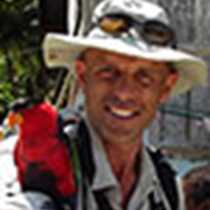Bahia Blanca, Argentina
After leaving Uruguay behind us once more, we find ourselves in a new South American country. This morning we cruised up the expansive estuary of the Rio Negro and entered the port of Bahia Blanca, our first stop in Argentina. On our way up the estuary we were treated to views of the rarely observed Franciscana, or La Plata, dolphin and the rare and local Olrog’s gull.
Bahia Blanca is a major point of access for the agricultural region of the pampas and a significant deep water port. The city is home to about 300,000 people, but this was not our destination for the day. Instead we headed about 100 km inland across the flat and fertile pampas to the mountains of Parque Provincial Ernesto Tornquist. Created in May 1937 when the land was donated by the Tornquist family, the park covers over 6,000 hectares of pampas and includes the 1,134 mile peak Cerro Ventana. The peak is named for a natural window near the summit measuring 8 metres high, 5 metres wide and 10 metres deep; the remains of a cave whose back wall fell away.
The park preserves a wide range of species native to the pampas, an area otherwise greatly altered by intensive agricultural development. While walking in the park we had the opportunity to see some of the native flora and fauna. We are here in spring, and although this year has been a very dry year there were many attractive flowering plants to be found, such as the intensely red Glandularia peruviana (pictured). And while the area is a park, we learned about the problems still facing this fragile habitat. For example, the beautiful feral horses that roam across this landscape are one such cause for concern. The horses out-compete the guanaco, a member of the llama family which is the native large herbivore in the region.
While the guanaco is still found in the area, although in reduced numbers, sadly the same cannot be said for the native Indian population of the area. Today we saw evidence of their presence in some primitive rock art in a remote cave. It is too late to preserve them, but hopefully the other native inhabitants of the region can find a future within the park.
After leaving Uruguay behind us once more, we find ourselves in a new South American country. This morning we cruised up the expansive estuary of the Rio Negro and entered the port of Bahia Blanca, our first stop in Argentina. On our way up the estuary we were treated to views of the rarely observed Franciscana, or La Plata, dolphin and the rare and local Olrog’s gull.
Bahia Blanca is a major point of access for the agricultural region of the pampas and a significant deep water port. The city is home to about 300,000 people, but this was not our destination for the day. Instead we headed about 100 km inland across the flat and fertile pampas to the mountains of Parque Provincial Ernesto Tornquist. Created in May 1937 when the land was donated by the Tornquist family, the park covers over 6,000 hectares of pampas and includes the 1,134 mile peak Cerro Ventana. The peak is named for a natural window near the summit measuring 8 metres high, 5 metres wide and 10 metres deep; the remains of a cave whose back wall fell away.
The park preserves a wide range of species native to the pampas, an area otherwise greatly altered by intensive agricultural development. While walking in the park we had the opportunity to see some of the native flora and fauna. We are here in spring, and although this year has been a very dry year there were many attractive flowering plants to be found, such as the intensely red Glandularia peruviana (pictured). And while the area is a park, we learned about the problems still facing this fragile habitat. For example, the beautiful feral horses that roam across this landscape are one such cause for concern. The horses out-compete the guanaco, a member of the llama family which is the native large herbivore in the region.
While the guanaco is still found in the area, although in reduced numbers, sadly the same cannot be said for the native Indian population of the area. Today we saw evidence of their presence in some primitive rock art in a remote cave. It is too late to preserve them, but hopefully the other native inhabitants of the region can find a future within the park.




